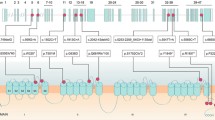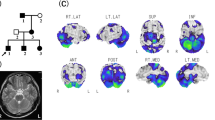Abstract
Episodic ataxia type 2 (EA2) is an autosomal dominant inherited neurological disorder that is characterized by paroxysmal episodes of ataxia. The causative gene for EA2 is CACNA1A which codes for the alpha 1A subunit of the voltage-gated P/Q-type calcium channel (Cav2.1). We detected a novel point mutation in the CACNA1A gene in a large Austrian family. All ten affected family members harbored a heterozygous c.3089+2T>C nucleotide exchange in intron 19. In silico modeling demonstrated a loss of the splice site of exon 19 by the mutation, which most likely results in exon skipping without frameshifting or use of an alternative splice site. Clinically, the family exhibited frequent ataxic episodes accompanied by headache in some individuals, which showed a good treatment response to acetazolamide or aminopyridine. Interictal phenotype variability was high ranging from an unremarkable clinical examination to a progressive cerebellar syndrome. Detailed cognitive testing with standardized neuropsychological tests revealed specific deficits in various domains including memory, executive functions and visual abilities. Moreover, a striking coincidence of socio-phobic behavior and anxiety disorders was detected within this family, which interfered with activities of daily living and has to be taken in consideration in EA2 patient management. We here characterize the phenotype of this novel CACNA1A mutation, review the respective literature and discuss implications on diagnosis and patient management.

Similar content being viewed by others
References
Westenbroek RE, Sakurai T, Elliott EM, Hell JW, Starr TV, Snutch TP, Catterall WA (1995) Immunochemical identification and subcellular distribution of the alpha 1A subunits of brain calcium channels. J Neurosci 15:6403–6418
Mori Y, Friedrich T, Kim MS, Mikami A, Nakai J, Ruth P, Bosse E, Hofmann F, Flockerzi V, Furuichi T et al (1991) Primary structure and functional expression from complementary DNA of a brain calcium channel. Nature 350:398–402
Mantuano E, Veneziano L, Jodice C, Frontali M (2003) Spinocerebellar ataxia type 6 and episodic ataxia type 2: differences and similarities between two allelic disorders. Cytogenet Genome Res 100:147–153
Jodice C, Mantuano E, Veneziano L, Trettel F, Sabbadini G, Calandriello L, Francia A, Spadaro M, Pierelli F, Salvi F, Ophoff RA, Frants RR, Frontali M (1997) Episodic ataxia type 2 (EA2) and spinocerebellar ataxia type 6 (SCA6) due to CAG repeat expansion in the CACNA1A gene on chromosome 19p. Hum Mol Genet 6:1973–1978
Romaniello R, Zucca C, Tonelli A, Bonato S, Baschirotto C, Zanotta N, Epifanio R, Righini A, Bresolin N, Bassi MT, Borgatti R (2010) A wide spectrum of clinical, neurophysiological and neuroradiological abnormalities in a family with a novel CACNA1A mutation. J Neurol Neurosurg Psychiatry 81:840–843
Jen J, Kim GW, Baloh RW (2004) Clinical spectrum of episodic ataxia type 2. Neurology 62:17–22
Jen JC, Graves TD, Hess EJ, Hanna MG, Griggs RC, Baloh RW (2007) Primary episodic ataxias: diagnosis, pathogenesis and treatment. Brain 130:2484–2493
Griggs RC, Moxley RT 3rd, Lafrance RA, McQuillen J (1978) Hereditary paroxysmal ataxia: response to acetazolamide. Neurology 28:1259–1264
Strupp M, Kalla R, Dichgans M, Freilinger T, Glasauer S, Brandt T (2004) Treatment of episodic ataxia type 2 with the potassium channel blocker 4-aminopyridine. Neurology 62:1623–1625
Strupp M, Kalla R, Claassen J, Adrion C, Mansmann U, Klopstock T, Freilinger T, Neugebauer H, Spiegel R, Dichgans M, Lehmann-Horn F, Jurkat-Rott K, Brandt T, Jen JC, Jahn K (2011) A randomized trial of 4-aminopyridine in EA2 and related familial episodic ataxias. Neurology 77:269–275
Schmitz-Hubsch T, du Montcel ST, Baliko L, Berciano J, Boesch S, Depondt C, Giunti P, Globas C, Infante J, Kang JS, Kremer B, Mariotti C, Melegh B, Pandolfo M, Rakowicz M, Ribai P, Rola R, Schols L, Szymanski S, van de Warrenburg BP, Durr A, Klockgether T, Fancellu R (2006) Scale for the assessment and rating of ataxia: development of a new clinical scale. Neurology 66:1717–1720
Helmstaedter C, Durwen HF (1990) The verbal learning and retention test. A useful and differentiated tool in evaluating verbal memory performance. Schweiz Arch Neurol Psychiatr 141:21–30
Meyers JE, Meyers KR (1995) Rey Complex Figure Test and Recognition Trial. PAR, Odessa
Horn W (1983) Leistungsprüfsystem L-P-S. Hogrefe, Göttingen
Jackson M, Warrington EK (1986) Arithmetic skills in patients with unilateral cerebral lesions. Cortex 22:611–620
Willmes K, Poeck K, Weniger D, Huber W (1983) Facet theory applied to the construction and validation of the Aachen Aphasia Test. Brain Lang 18:259–276
Mateer C, Kimura D (1977) Impairment of nonverbal oral movements in aphasia. Brain Lang 4:262–276
Härting C, Markowitsch HJ, Neufeld H (2000) Wechsler Gedächtnis-Test - Revidierte Fassung. Verlag Hans Huber, Bern
Zimmermann P, Fimm B (2007) Testbatterie zur Aufmerksamkeitsprüfung. Version 2.1. Psytest, Herzogenath
Aschenbrenner S, Tucha O, Lange KW (2001) Regensburger Wortflüssigkeits-Test. Hogrefe, Göttingen
Haid T, Martl C, Schubert F (2003) The Hamasch-5-Point-Test-Better Normative Data. J Int Neuropsychol Soc 4:521
Reitan RM, Wolfson D (1985) The Halstead-Reitan neuropsychological test battery. Neuropsychological Press, Tucson, AZ
Flowers KA, Robertson C (1985) The effect of Parkinson’s disease on the ability to maintain a mental set. J Neurol Neurosurg Psychiatry 48:517–529
Kohler J (2004) Der Planungstest-Softwareprogramm zur Diagnostik von Planungsstörungen. In: EnJoiME Software (Beck & Kohler GbR). Konstanz
Lehrl S, Merz J, Burkard G, Fischer B (1991) Mehrfachwahl-Wortschatz Intelligenz Test. In: Peri-Med Fachbuch. Erlangen
Houdayer C, Dehainault C, Mattler C, Michaux D, Caux-Moncoutier V, Pages-Berhouet S, d’Enghien CD, Lauge A, Castera L, Gauthier-Villars M, Stoppa-Lyonnet D (2008) Evaluation of in silico splice tools for decision-making in molecular diagnosis. Hum Mutat 29:975–982
Cleves C, Parikh S, Rothner AD, Tepper SJ (2010) Link between confusional migraine, hemiplegic migraine and episodic ataxia type 2: hypothesis, family genealogy, gene typing and classification. Cephalalgia 30:740–743
Jen J, Yue Q, Nelson SF, Yu H, Litt M, Nutt J, Baloh RW (1999) A novel nonsense mutation in CACNA1A causes episodic ataxia and hemiplegia. Neurology 53:34–37
Alonso I, Barros J, Tuna A, Coelho J, Sequeiros J, Silveira I, Coutinho P (2003) Phenotypes of spinocerebellar ataxia type 6 and familial hemiplegic migraine caused by a unique CACNA1A missense mutation in patients from a large family. Arch Neurol 60:610–614
Jen J, Wan J, Graves M, Yu H, Mock AF, Coulin CJ, Kim G, Yue Q, Papazian DM, Baloh RW (2001) Loss-of-function EA2 mutations are associated with impaired neuromuscular transmission. Neurology 57:1843–1848
Baloh RW, Yue Q, Furman JM, Nelson SF (1997) Familial episodic ataxia: clinical heterogeneity in four families linked to chromosome 19p. Ann Neurol 41:8–16
Scoggan KA, Chandra T, Nelson R, Hahn AF, Bulman DE (2001) Identification of two novel mutations in the CACNA1A gene responsible for episodic ataxia type 2. J Med Genet 38:249–253
Kaunisto MA, Harno H, Kallela M, Somer H, Sallinen R, Hamalainen E, Miettinen PJ, Vesa J, Orpana A, Palotie A, Farkkila M, Wessman M (2004) Novel splice site CACNA1A mutation causing episodic ataxia type 2. Neurogenetics 5:69–73
Denier C, Ducros A, Durr A, Eymard B, Chassande B, Tournier-Lasserve E (2001) Missense CACNA1A mutation causing episodic ataxia type 2. Arch Neurol 58:292–295
Self J, Mercer C, Boon EM, Murugavel M, Shawkat F, Hammans S, Hodgkins P, Griffiths H, Lotery A (2009) Infantile nystagmus and late onset ataxia associated with a CACNA1A mutation in the intracellular loop between s4 and s5 of domain 3. Eye (Lond) 23:2251–2255
Kim JM, Kim JS, Ki CS, Jeon BS (2006) Episodic ataxia type 2 due to a deletion mutation in the CACNA1A gene in a Korean family. J Clin Neurol 2:268–271
Spacey SD, Materek LA, Szczygielski BI, Bird TD (2005) Two novel CACNA1A gene mutations associated with episodic ataxia type 2 and interictal dystonia. Arch Neurol 62:314–316
Riant F, Mourtada R, Saugier-Veber P, Tournier-Lasserve E (2008) Large CACNA1A deletion in a family with episodic ataxia type 2. Arch Neurol 65:817–820
van den Maagdenberg AM, Kors EE, Brunt ER, van Paesschen W, Pascual J, Ravine D, Keeling S, Vanmolkot KR, Vermeulen FL, Terwindt GM, Haan J, Frants RR, Ferrari MD (2002) Episodic ataxia type 2. Three novel truncating mutations and one novel missense mutation in the CACNA1A gene. J Neurol 249:1515–1519
Jung J, Testard H, Tournier-Lasserve E, Riant F, Vallet AE, Berroir S, Broussolle E (2010) Phenotypic variability of episodic ataxia type 2 mutations: a family study. Eur Neurol 64:114–116
Guida S, Trettel F, Pagnutti S, Mantuano E, Tottene A, Veneziano L, Fellin T, Spadaro M, Stauderman K, Williams M, Volsen S, Ophoff R, Frants R, Jodice C, Frontali M, Pietrobon D (2001) Complete loss of P/Q calcium channel activity caused by a CACNA1A missense mutation carried by patients with episodic ataxia type 2. Am J Hum Genet 68:759–764
Choi KD, Yook JW, Kim MJ, Kim HS, Park YE, Kim JS, Choi JH, Shin JH, Kim DS (2013) Possible anticipation associated with a novel splice site mutation in episodic ataxia type 2. Neurol Sci
Krishnan AV, Bostock H, Ip J, Hayes M, Watson S, Kiernan MC (2008) Axonal function in a family with episodic ataxia type 2 due to a novel mutation. J Neurol 255:750–755
Cricchi F, Di Lorenzo C, Grieco GS, Rengo C, Cardinale A, Racaniello M, Santorelli FM, Nappi G, Pierelli F, Casali C (2007) Early-onset progressive ataxia associated with the first CACNA1A mutation identified within the I-II loop. J Neurol Sci 254:69–71
Robbins MS, Lipton RB, Laureta EC, Grosberg BM (2009) CACNA1A nonsense mutation is associated with basilar-type migraine and episodic ataxia type 2. Headache 49:1042–1046
Glasscock E, Qian J, Yoo JW, Noebels JL (2007) Masking epilepsy by combining two epilepsy genes. Nat Neurosci 10:1554–1558
Gargus JJ (2006) Ion channel functional candidate genes in multigenic neuropsychiatric disease. Biol Psychiatry 60:177–185
Jouvenceau A, Eunson LH, Spauschus A, Ramesh V, Zuberi SM, Kullmann DM, Hanna MG (2001) Human epilepsy associated with dysfunction of the brain P/Q-type calcium channel. Lancet 358:801–807
Guerin AA, Feigenbaum A, Donner EJ, Yoon G (2008) Stepwise developmental regression associated with novel CACNA1A mutation. Pediatr Neurol 39:363–364
Bertholon P, Chabrier S, Riant F, Tournier-Lasserve E, Peyron R (2009) Episodic ataxia type 2: unusual aspects in clinical and genetic presentation. Special emphasis in childhood. J Neurol Neurosurg Psychiatry 80:1289–1292
Mantuano E, Romano S, Veneziano L, Gellera C, Castellotti B, Caimi S, Testa D, Estienne M, Zorzi G, Bugiani M, Rajabally YA, Barcina MJ, Servidei S, Panico A, Frontali M, Mariotti C (2010) Identification of novel and recurrent CACNA1A gene mutations in fifteen patients with episodic ataxia type 2. J Neurol Sci 291:30–36
Karner E, Nachbauer W, Bodner T, Benke T, Boesch S, Delazer M (2012) Long-term outcome of cognitive functions, emotional behavior, and quality of life in a family with familial hemiplegic migraine. Cogn Behav Neurol 25:85–92
Eunson LH, Graves TD, Hanna MG (2005) New calcium channel mutations predict aberrant RNA splicing in episodic ataxia. Neurology 65:308–310
Wan J, Carr JR, Baloh RW, Jen JC (2005) Nonconsensus intronic mutations cause episodic ataxia. Ann Neurol 57:131–135
Acknowledgments
The authors would like to acknowledge Andreas Janecke for his advice and support in genetic counselling.
Conflicts of interest
The authors declare no conflict of interest.
Author information
Authors and Affiliations
Corresponding author
Electronic supplementary material
Below is the link to the electronic supplementary material.
Rights and permissions
About this article
Cite this article
Nachbauer, W., Nocker, M., Karner, E. et al. Episodic ataxia type 2: phenotype characteristics of a novel CACNA1A mutation and review of the literature. J Neurol 261, 983–991 (2014). https://doi.org/10.1007/s00415-014-7310-2
Received:
Revised:
Accepted:
Published:
Issue Date:
DOI: https://doi.org/10.1007/s00415-014-7310-2




